Pembroke Dockyard was founded in 1814, and two years later launched its first wooden ships. The town grew from nothing into a lively and prosperous place, but by the advent of the iron clad warships, the dockyard was threatened with closure. During the Great War, the Royal Dockyards at Pembroke Dock were given a new lease of life.
Workers at the Dockyard built many vessels, some being lost during the course of the Great War. HMS Amphion was mined in 1914; HMS Nottingham was torpedoed in 1916; HMS Warrior and HMS Defence were sunk at the Battle of Jutland on 31 May 1916. The United States Coastguard cutter Tampa, based in Pembroke Dock, was sunk with all hands; HMS Drake was torpedoed in 1917; HMS Goliath, which had been based at Pembroke Dock before the war, was lost off the coast of Gallipoli with several local men aboard. HM Submarine J6 was accidentally sunk on 15 October 1918. Many of these vessels had local men serving aboard them. The Dockyard closed in 1926. By this time over 250 ships, plus five Royal Yachts, had been built.
Pembroke Dockyards had employed thousands of workers, and, doing work of vital importance, these workers were immune to conscription. However, many gave up their safe positions, and volunteered for service overseas. The fine carved oak and parchment memorial which is situated in Pembroke Town Hall commemorates the four hundred men of Pembroke Dockyard who joined the armed forces. Many won medals for gallantry, and twenty four lost their lives. Many thanks to Hugh Colley, Pembroke Town Clerk, for photographing the War Memorial for me.
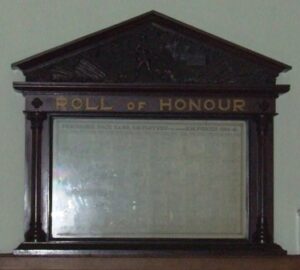
Pembroke Dockyard Roll of Honour
Bertie Thomas Ashmore, Private, 899, Welsh Regiment. Bertie was the son of Charles and Caroline Ashmore, of 32, Lewis Street, Pembroke Dock. He enlisted at Carmarthen at the outbreak of war into the 1/4th Battalion, the Welsh Regiment. The battalion was the local Territorial infantry unit, and formed for war at Carmarthen from 4 August 1914, attached to South Wales Brigade, Army Troops. During November 1914 it moved to Tunbridge Wells, and in February 1915 moved to Scotland on the Forth and Tay Defences. On 17 April 1915 the battalion joined 159 Brigade, 53rd (Welsh) Division, at Bedford, and on 19 July 1915 sailed from Devonport for Mudros, arriving on 5 August, before being transferred to Suvla Bay, Gallipoli on 9 August 1915. Immediately the 1/4th Welsh became embroiled in heavy fighting, against strongly defended Turkish trenches. Bertie was killed on the following day, 10 August 1915, during a charge against a Turkish post. He was 23 years old, and like so many of the men killed at Gallipoli, is commemorated on the Helles Memorial, Gallipoli.
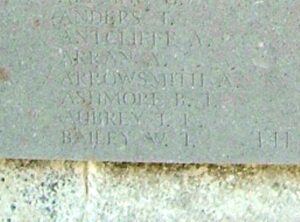
Charles Ernest Badrick, Sergeant, 50140, Royal Engineers. Charles was born in 1882, the son of Joseph and Rebecca Badrick, of 7, Green Terrace, Hubberston, Milford Haven. He enlisted at Milford into the Royal Engineers, and was posted to their 98th Field Company, which was on the Western Front, attached to the 21st Division. The Division crossed to France between 2 and 13 September 1915, and its first experience of battle was truly appalling. Having been in France for only a few days, lengthy forced marches brought it into the reserve for the British assault at Loos. GHQ planning left it too far behind to be a useful reinforcement on the first day, but it was sent into action on 26 September, whereupon it suffered over 3,800 casualties for very little gain. The Division remained in the area north of Loos over the coming winter, and it was here that Charles was killed in action on 1 December 1915, aged 33. Charles is buried at Chapelle-D’Armentieres New Military Cemetery, France.
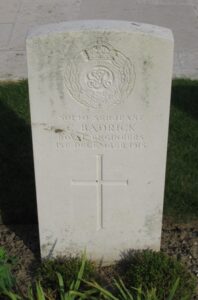
Edgar James Ball, Driver, 14484, Royal Field Artillery. Edgar was the son of Hugh and Minnie Ball, of 8, King Street, Pembroke Dock. He enlisted at Pembroke into the Royal Field Artillery, and was posted to the 28th Brigade Ammunition Column, which was an Army Brigade, attached to 2nd Army. Edgar fought at the Battle of Passchendaele throughout the summer of 1917, and this is where he became wounded, after the main Battle had been called to a halt. Edgar was taken to a Casualty Clearing Station just north of Poperinghe, where he died of his wounds on 5 December 1917. Edgar was 27 years old, and was buried at Dozinghem Military Cemetery, Belgium.
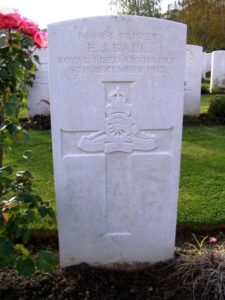
William John Beddoe, Private, 16882, Essex Regiment. William was the son of John and Sarah Beddoe, of Pembroke Dock. He enlisted at Pembroke into the Army, and was posted to the 9th Battalion, Essex Regiment. The Battalion formed part of 35 Brigade, 12th (Eastern) Division. The Division landed at Boulogne on 31 May 1915, and took over the line at Ploegsteert Wood. They then moved south and fought in the Battle of Loos, and the subsequent actions of the Hohenzollern Redoubt, and remained there until March 1916. William was killed in action near Loos, just before the Division moved to the Somme, on 30 March 1916. He was 30 years old, and is buried at Vermelles British Cemetery, France.
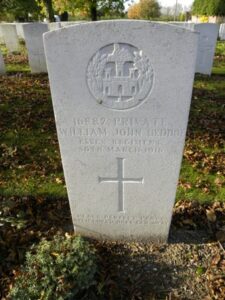
Frederick Brooks, Gunner, 14483, Royal Field Artillery. Frederick was the son of Joseph and Sarah Brooks of Pembroke. He enlisted at Pembroke into the Royal Field Artillery, and was posted to ‘B’ Battery, 92nd Brigade, which was attached to the 20th (Light) Division. On 26 July 1915 the Division completed concentration in the Saint-Omer area, all units having crossed to France during the preceding few days. Early trench familiarisation and training took place in the Fleurbaix area. When the Battle of Loos was launched on 25 September 1915 the Division fought a diversionary attack towards Fromelles. Later that year they moved north, and fought at the Battle of Mount Sorrel alongside the Canadian Corps. Over the winter of 1915/16, the Division remained in positions south of Ypres, and fought at the Battle of Mount Sorrel in June, alongside the Canadian Corps. They then fought through the Somme Offensive, at the Battles of Delville Wood, Guillemont, Flers-Courcelette, Morval and Le Transloy. Frederick was killed in action during the fighting at Le Transloy, on 3 November 1916. He was just 22 years old, and is buried at Carnoy Military Cemetery, France.
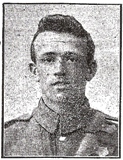
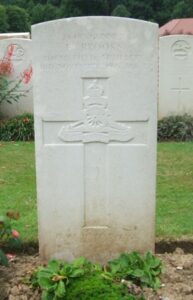
Frederick William Clarke, Sapper, 47409, Royal Engineers. Frederick was the son of James and Elizabeth Clarke, of 2, Robert Street, Milford Haven. He was one of three brothers who enlisted at Milford into the Royal Engineers on 4 September 1914. Frederick and his brother Benjamin were posted to their 98th Field Company, which was attached to the 21st Division. The 98th F.C. crossed to France with the division on 10 September 1915, and its first experience of battle was horrific, suffering almost 4,000 casualties at the Battle of Loos. The division moved to the Somme in 1916, and fought at the Battle of Albert, then at the Battle of Bazentin Ridge. This is where Frederick was killed in action on 14 July 1916, aged 26, with his brother Benjamin by his side. Frederick was 26 years old, and is commemorated on the Thiepval Memorial, France.
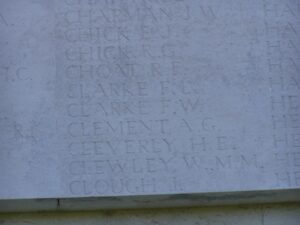
William George Edwards, Sapper, 15442, Royal Engineers. William was the son of Thomas and Hannah Edwards, of Court House, Hubberston. He worked at HM Dockyard prior to the war, and enlisted at Pennar into the Royal Engineers. After receiving his training, he was posted to the 11th Field Company, Royal Engineers, which was attached to the 2nd Division. One of the first Divisions to move to France, the 2nd Division remained on the Western Front throughout the war. They moved to Belgium, where they fought at the Battle of Mons, and retreating southwards, fought at the Affair of Landrecies, the Rearguard Actions of Villers-Cotterets, and at the Battle of the Marne where the German offensive was stopped. The Germans retreated north, and the BEF met them, fighting at the Battle of the Aisne. The 2nd Division were then moved to Flanders, where they fought at the First Battle of Ypres, when the German sweep through Flanders was stopped, and remained there throughout the first winter of the war. William died in Flanders on 11 January 1915, aged 28. He is buried at Le Touret Military Cemetery, Richebourg-L’Avoue, France.
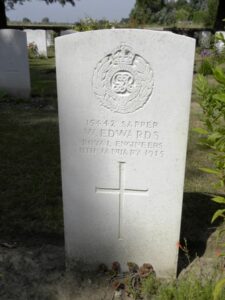
William James Edwards, Private, 91139, Machine Gun Corps. William was the son of James and Mary Edwards, of 13, Frederick Street, Neyland. He worked at Pembroke Dockyard prior to the war, and he enlisted at Pembroke on 11 December 1915 into the Army. He was posted to France on 10 August 1917, joining the 24th Company, Machine Gun Corps, which was attached to 24 Brigade, 8th Division. William saw his first action during the Battle of Langemarck in August 1917. William was only at the front for two months when he was killed in action at Ypres on 27 November 1917, aged 20. He has no known grave, and is commemorated on the Tyne Cot Memorial, Belgium.
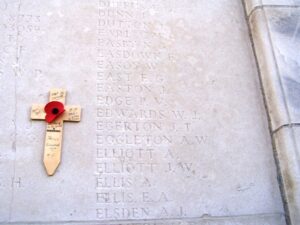
Harry Ellis, Sapper, 95232, Royal Engineers. Henry (Harry) was born at Pembroke Dock in 1896, the son of John George and Mary Anne Ellis, of 30, Queen Street. His parents later resided at 11, Elksley Road, Warsop, Mansfield, Notts. Harry served his apprenticeship at Portsmouth Dockyard before returning to work at Pembroke Dockyard prior to the war. He enlisted at Pembroke Dock into the Royal Engineers, being posted to their 131st Field Company, which was attached to the 26th Division. Embarkation for France began in September 1915, and the concentration of units at Guignemicourt, west of Amiens, was completed before the end of the month. However in November 1915 the Division moved to Salonika, where it then remained. On 26 December 1915 units began to move from Lembet to Happy Valley Camp, and all units were in place there by 8 February. The Division then took part in the Battle of Horseshoe Hill, between 10-18 August 1916, the Battle of Doiran between 24-25 April and 8-9 May 1917. Harry was killed in action the following summer, on 17 May 1918. He was 21 years old, and is commemorated on the Doiran Memorial, Salonika. Harry was the holder of the Italian ‘Al Valore Militaire’. (Bronze Medal for Military Valour).
David Edgar Evans, Lance Corporal, 9746, Royal Fusiliers. David was born in 1895, the son of John Thomas Evans and Frances Bell Evans, of 101, Gwyther Street, Pembroke Dock. He enlisted at Pembroke Dock into the Army, and was posted to the 7th Battalion, Royal Fusiliers, which was attached to 190 Brigade, 63rd (Royal Naval) Division. The Naval Brigades were originally sent to Antwerp and Dunkirk in September and October, 1914 to guard against invasion by the Germans. However Antwerp fell to the Germans soon after, and so many of the RND units were withdrawn to England. After a lengthy period of refit and training the Division moved to Egypt preparatory to the Gallipoli campaign. Landing on 25 April 1915, the Division fought throughout the Campaign on Gallipoli. They were transferred from the authority of the Admiralty to the War Office on 29 April 1916, and was re-designated the 63rd (Royal Naval) Division on 19 July 1916. The Division moved to France, arriving at Marseilles between 12 and 23 May 1916 and moved to positions on the Somme, where it took part in the Battle of the Ancre, and the resulting Operations on the Ancre. David was killed on the Ancre on 13 November 1916, aged 21. He is buried in Ancre British Cemetery, Beaumont Hamel, France.
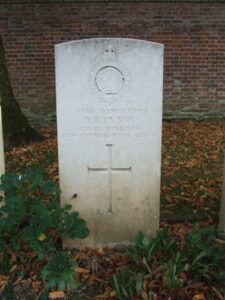
James Sinclair Graham, MID, Corporal, 14584, Royal Engineers. James was the son of Peter and Jane Graham, of Pembroke Dock, and the husband of Anne Graham, of 48, Military Road, Pennar, Pembroke Dock. He enlisted at Pembroke into the Royal Engineers at some time prior to 1911, and at the outbreak of war landed in France with the BEF. James was later posted to the 57th Field Company, Royal Engineers, which was attached to the 49th (West Riding) Division. The Division moved to France between 12 and 19 April 1915 and saw its first major action on the Somme, during the Battle of Albert. They remained on the Somme, taking part in the Battle of Bazentin, the Battle of Pozieres, and the Battle of Flers-Courcelette, and the following year saw action at Third Ypres, during the Battle of Poelcapelle. James was wounded here, and brought back to Ypres for treatment, but sadly he died of his wounds on 13 October 1917, aged 36. James is buried at Ypres Reservoir Cemetery, Belgium, in grave ref. I. H. 30. James was Mentioned in Sir Douglas Haig’s Despatches for bravery during his time at war.
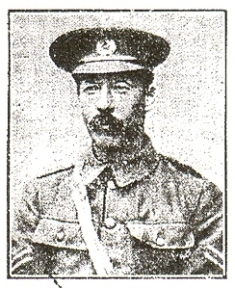
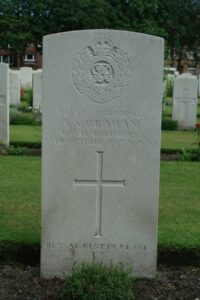
David Arthur Griffiths, Ordinary Seaman, Z/5091, Royal Navy. David was born on 22 June 1900, the son of David and Ellen Griffiths, of 2, Annesley Street, Llanelly. He was a Boy Writer at Pembroke Dockyard, prior to serving as Ordinary Seaman in the Royal Navy, at HMS Victory VI. The base was a training base for recruits, based at Crystal Palace. David took ill while training here, and died of pneumonia on 14 October 1918, aged just 18. His remains were brought home for burial at Llanelli (Box) Cemetery, Wales, in grave ref. II. 23. 3. David is not listed among the war dead on the Dockyard Memorial.
John Alfred Griffiths, Sergeant, 17945, Welsh Regiment. John was born at Walwyn’s Castle in 1889, the son of Mary Griffiths. Mary was widowed prior to 1901, and married George Bailey Richards, of 5, Fleet Street, Pennar. John was raised at Pennar, and worked as a Policeman at Mumbles prior to the war. He enlisted there into the 14th Battalion, Welsh Regiment, which was known as the Swansea Pals. The Battalion was raised at Swansea by the Mayor and Corporation with the Swansea Football and Cricket Club, and moved to Rhyl in 129 Brigade, 43rd Division. After training, the Division moved to Winchester, where the formation became 114 Brigade, 38th (Welsh) Division, and in December 1915 landed at Le Havre. The Division moved to positions in the so called Nursery Sector near Fleurbaix, and received instruction in trench warfare from the Guards and 19th Divisions. It moved to positions on the La Bassée Canal in the spring of 1916. The 14th Welsh were in the front line trenches at Givenchy when John was killed, on 13 March 1916, aged 27. He is buried at Guards Cemetery, Windy Corner, Cuinchy, France.
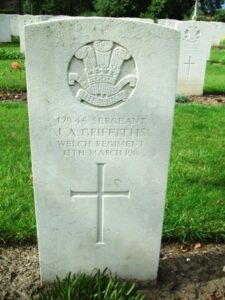
John Hutchings, Private, 201971, Welsh Regiment. John was the son of Simon and Martha Hutchings, of Guilford, Llangwm. He enlisted at Pembroke Dock into the Welsh Regiment, and was posted to the 18th Battalion, which was attached to 119 Brigade, 40th (Bantam) Division. This Division was formed between September and December 1915, composed of bantam units and others which had a mixture of regulation-height and shorter men. Weeding out of very under-sized or unfit men delayed the training programme, and it was not until late Spring 1916 that the Division was ready to proceed on active service. The Division moved to France between 1-9 June, and moved to the front near Loos. Late in 1916 they moved south to the Somme, and fought at the Battle of the Ancre, and remained in the area over the winter. In March, 1917 the Germans withdrew to their shortened line, called the Hindenburg Line, and the 40th Division were one of the Divisions that followed the withdrawal. Later in the year they took part in the Battle of Cambrai, playing an important role in the attack on Bourlon Wood. John was killed in action at Bourlon Wood on 24 November 1917, aged 36. He is commemorated on the Cambrai Memorial, Louverval, France.
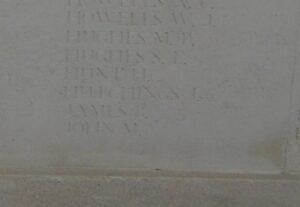
John Jones, Lance Corporal, 9250, Royal Welsh Fusiliers. John was the son of John and Mary Jones, of 20, Williamson Street, Orange Gardens, Pembroke. He enlisted at Tonypandy on 4 September 1906 into the Royal Welsh Fusiliers, and had served in India for several years prior to returning home. At the outbreak of war John was serving with the 1st Battalion, Royal Welsh Fusiliers, which was attached to 22 Brigade, 7th Division. The Division was formed during September 1914 and landed at Zeebrugge on the 6th October, 1914. The City was already falling however, and so the Division was moved to Ypres, where they became the first British Division to hold the city. They fought during the First Battle of Ypres, and helped stop the German advance through Belgium, and in March, 1915 fought at the Battle of Neuve Chapelle. During May they fought at the Battle of Aubers Ridge, and at Festubert, before taking part in the Battle of Loos in September. John survived Loos, but was killed in action later in the year, on 30 October 1915, aged 30. He is buried at Guards Cemetery, Windy Corner, Cuinchy, France.
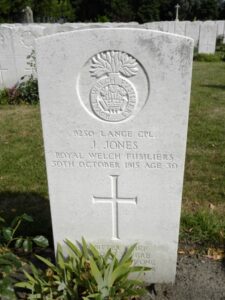
William James Jones, Private, M/295967, Tank Corps. William was the son of Daniel and Margaret Jones, of Church Street, Cilgerran. He worked as a carpenter at Pembroke Dockyard prior to the war, and enlisted at Fishguard into the Army Service Corps, most probably as a Motor Driver, and landed in France on 22 August 1917. William was then attached to the 8th Battalion of the Tank Corps. He was caught up in the heavy fighting that resulted from the German Spring Offensive on the Somme during March 1918. William became ill during this tumultuous period, and was evacuated to No. 12 Stationary Hospital at St. Pol, where he died of meningitis on 30 April 1918, aged 20. He is buried at St. Pol British Cemetery, St. Pol-Sur-Ternoise, near Arras in Northern France.
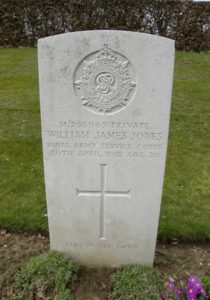
Harry Ernest Lambert, Warrant Wardmaster, Royal Navy. Harry was born at Winchester in 1870, the son of Robert and Sarah Jane Lambert. He resided with his wife Emily Lambert, at 33, Park Street, Pembroke Dock, where he served as Warrant Wardmaster at Pembroke Dock Royal Naval Hospital. Harry died after the end of the war, on 17 December 1919. He was 49 years old, and is buried at Pembroke Dock (Llanion) Cemetery.
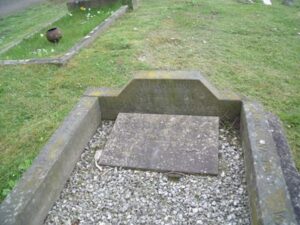
Albert Seymour Lloyd, MM, Gunner, 15757, Royal Field Artillery. Albert was the son of Alderman William George Lloyd and Margaret Anne Lloyd, of Britannia House, Corporation Terrace, Pembroke Dock. He was an Apprentice in HM Dockyard, Pembroke Dock, but enlisted at Pembroke into the Royal Field Artillery. Albert was posted to ‘C’ Battery, 78th Brigade, which was attached to the 17th (Northern) Division. Between 12 to 17 July 1915 the Division landed in France. They spent their initial period of trench familiarisation and then holding the front lines in the southern area of the Ypres salient. Here they took part in fighting at the Bluff during February, 1916 before moving south, where they fought at the Battle of Albert, where the Division captured Fricourt at heavy cost during the opening of the Somme Offensive. They then saw action during the Battle of Arras, at the First Battle of the Scarpe, and it was here that Albert was killed when a German shell crashed into his gunpit near Monchy on 19 April 1917. He was 23 years old, and is buried at Tilloy British Cemetery, Tilloy-Les-Mofflaines, France, in grave ref. I. E. 35. Albert had been awarded the Military Medal for bravery during the Battle of the Somme in 1916.
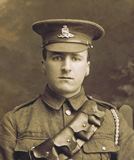
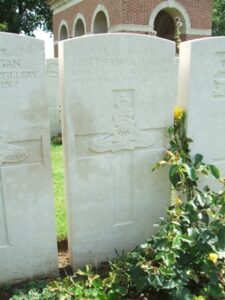
Thomas Lloyd, Private, 125, Welsh Regiment. Thomas was the son of Thomas and Maria Lloyd, of 41, Front Street, Pembroke Dock. He had been one of the early enlistees into the 1/4th Battalion, Welsh Regiment at the outbreak of war, so was probably a serving Territorial. The battalion was the local Territorial infantry unit, and formed for war at Carmarthen from 4 August 1914, attached to South Wales Brigade, Army Troops. During November 1914 it moved to Tunbridge Wells, and in February 1915 moved to Scotland on the Forth and Tay Defences. On 17 April 1915 the battalion joined 159 Brigade, 53rd (Welsh) Division, at Bedford, and on 19 July 1915 sailed from Devonport for Mudros, arriving on 5 August, before being transferred to Suvla Bay, Gallipoli on 9 August 1915. Immediately the 1/4th Welsh became embroiled in heavy fighting, against strongly defended Turkish trenches. Desperate fighting ensued over the coming weeks, which also saw terrible sickness raging through the men due to the amount of corpses littered over the battlefields. Thomas took ill on Gallipoli and was evacuated to a Hospital Ship moored offshore, but sadly he died on 18 September 1915 aged 25, and was buried at sea. Thomas is commemorated on the Helles Memorial, Gallipoli.
Henry McCormick, Driver, 14534, Royal Field Artillery. Henry was the son of Henry and Charlotte Ann McCormick, of 14, King Street, Pembroke Dock. He had enlisted at Pembroke into the Royal Field Artillery, and served on the Western Front with the 42nd Division Ammunition Column. The Division had fought at Gallipoli and Egypt before moving to the Western Front in February 1917, taking over the line near Epehy then Havrincourt. In September they moved north to Ypres, where they fought through Third Ypres, until moving to the Coast in September to refit. November 1917 saw them moving to positions at Givenchy, where they remained until moving back south in early 1918. Here they faced the German Spring Offensive of 21 March on the Somme, and fought in the Battle of Bapaume, and then at Arras. The offensive stalled for several months, until an Australian victory at Villers Brettoneux on 8 August saw the tide of war turn. The British attacked the German lines on the Somme on 21 August, with the 42nd Division in the line, and began the great offensive that was eventually to end the war. The Division fought at the Battle of Albert, then the Battle of Bapaume, and on to the Canal du Nord, and the pursuit to the Selle, where they saw out the end of the war. Henry died of influenza in France on 6 March 1919, aged 24. He is buried at Charleroi Communal Cemetery, Belgium, in grave ref. L. 7. His brother John had been killed in France in 1917.
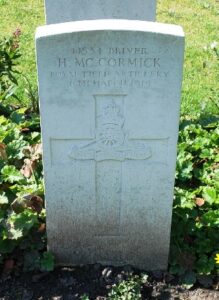
James Clifford Morgan, Private, 20049, Leinster Regiment. James was the son of W. H. and Annie Morgan, of Mayfield House, Burton. He enlisted at Haverfordwest into the Pembroke Yeomanry, but was later transferred to the 2nd Battalion, Leinster Regiment, which was attached to 88 Brigade, 29th Division. The Division had forged a reputation fighting at Gallipoli in 1915, before moving to the Western Front, where it suffered heavy losses in the Somme Battles. In the Spring of 1917 they fought at the Battle of the Scarpe, which was part of the Arras Offensive, and then moved further north to Ypres. Here they fought at the Battle of Langemarck, and then at the Battles of the Menin Road, Polygon Wood, Broodseinde and Poelcappelle, before moving to Cambrai. Here they fought at the Battle of Cambrai in November and December, 1917 before moving back to Flanders early in 1918. The German Spring Offensive hit the British on the Somme on 21 March, 1918, and hit in Flanders just weeks later. The 29th Division fought at the desperate defensive battles of the Lys. James was wounded during the offensive in Flanders in August 1918. He was evacuated to the Hospital at St. Omer where he died of his wounds on 6 September 1918. James was 25 years old, and is buried at Longuenesse (St. Omer) Souvenir Cemetery, France.
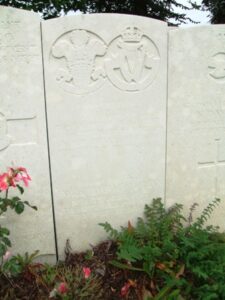
Frederick Charles Pellow, DSM, Able Seaman, 196467, Royal Navy. Frederick was born at Newton Abbot, Devon on 12 December 1880, the son of Charles and Eliza Pellow. The family moved to Waterloo, St. Mary’s, Pembroke by 1888, and another son, John, was born there. Frederick served in the Mercantile Marine prior to enlisting into the Royal Navy, and served aboard the battleship HMS Caesar. After an active war, Caesar was sent to Malta in September 1918 to be converted to a Depot Ship. Frederick died at Malta on 3 October 1918, aged 38. He is buried at Malta (Capuccini) Naval Cemetery, Malta. Frederick had been awarded the Distinguished Service Medal in the London Gazette of 12 May 1916, ‘in recognition of the services of Petty Officers and men of the Eastern Mediterranean Squadron during the evacuation of the Gallipoli Peninsula in December, 1915-January, 1916.’
Morgan Price, Lance Corporal, 16349, Royal Welsh Fusiliers. Morgan was the son of Rees and Elizabeth Price of Llandewi Brefi, Cardiganshire. He had worked at the Dockyard before getting married, and lived with his wife Sarah Mary Price, at 40, Elm Street, Ferndale, Glamorgan. Morgan returned to Pembroke to enlist into the Army, and joined the 9th Battalion, Royal Welsh Fusiliers, which formed part of 58 Brigade, 19th (Western) Division. The Division assembled around Bulford during September 1914. Divisional training was completed near Tidworth, from March 1915, and the Butterfly Division crossed to France between 11 and 21 July 1915, and moved to positions near Loos. The Division fought during the opening attack of the Battle of Loos, and it was during this initial attack on 25 September 1915 that Morgan was killed. He was 39 years old, and is commemorated on the Loos Memorial, France.
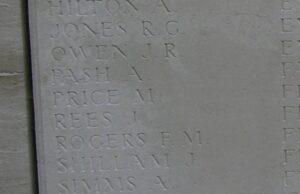
Lewis James Thomas, Private, 94123, Royal Welsh Fusiliers. Lewis was the son of James and Mary Thomas, and the brother of Elizabeth Ann Thomas, of 30, Milton Terrace, Pembroke Dock. He was a boiler maker at Pembroke Dockyard prior to enlisting on 7 December 1915 into the Monmouth Regiment. On 8 October 1918 Lewis embarked for France, and upon arrival was posted to the 17th Battalion, Royal Welsh Fusiliers, which was attached to 113 Brigade, 38th (Welsh) Division. The Division had been in France since December 1915, and had fought at Mametz Wood in 1916 and at Passchendaele in 1917. In 1918 it was moved to the Somme, from where it took part in the great offensive, which started on 23 August 1918. Lewis was killed when the Division was taking part in the Battle of the Selle on 21 October 1918. He was 22 years old, and is buried at Highland Cemetery, Le Cateau, France.
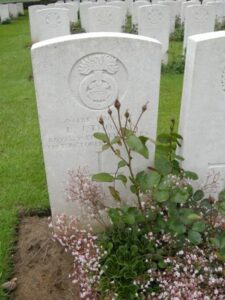
Frederick George Truscott, Private, 25713, Lancashire Fusiliers. Frederick was the son of Horatio George and Anne Prosser Truscott, of 70, Gwyther Street, Pembroke Dock. Frederick enlisted at Pembroke into the Royal Field Artillery, and was given the service number 137692. He was later transferred, probably due to earlier wounding or sickness, to the 12th Battalion, Lancashire Fusiliers, his number changing to 25713. The Battalion formed part of 65 Brigade, 22nd Division. The Division crossed to France in early September 1915, with all units being concentrated near Flesselles by 9 September. However it’s stay in France was to be very short, as on 27 October 1915 the Division, having been moved by train to Marseilles, began to embark for Salonika. It completed concentration there in November, although the final artillery units were still coming in as late as 13 December 1915. It remained in the theatre for the rest of the war, taking part in the Retreat from Serbia during December, 1915. From 10-18 August 1916 the Division fought at the battle of Horseshoe Hill, then from 13-14 September 1916 at the battle of Machukovo. From 24-25 April and 8-9 May 1917 the Division fought at the battle of Doiran. Frederick was killed in action near Doiran on 22 April 1918. He was 23 years old, and is commemorated on the Doiran Memorial, Salonika. Frederick is commemorated at St. John’s Church, which has a stained glass window dedicated to him.